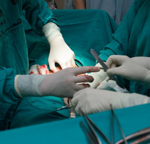

AMBULATORY PHLEBECTOMY
hen the size of the incompetent vein is too large for sclerotherapy or other less invasive treatments, surgical treatment might be necessary to properly address the problem. Ambulatory phlebectomy (also called mini, micro, or stab avulsion phlebectomy) is a surgical method of removing varicose veins at the surface of the skin. Small incisions are made next to the vein and sections of vein are removed through these small nicks. Often, endoveneous RFA (Venefit; formerly known as VNUS Closure) is done in conjunction with phlebectomy.
In the past, the removal of large varicose veins required "vein stripping" surgery that left unsightly scars. But using today's micro-incision phlebectomy techniques, the cosmetic outcome is much better as the tiny surgical incisions leave scars that are barely visible, if at all.
Ambulatory phlebectomy is an in-office procedure done using only local anesthesia and mild sedation. The patient is able to resume normal activities within the next few days.
What to expect during procedure
Phlebectomy can be outlined by the following steps:- Marking the leg to be treat before the procedure begins.
- Injecting local anesthesia into the skin.
- Surgical removal of the bulging veins, segment by segment, through small incisions.
- Leg wrapping and compression stockings are applied.
- Using Veinlite and ultrasound guidance, the doctor will mark the vein to be treated onto the skin. This will serve as a map of the problem areas during the procedure.
- Tumescent is administered into the areas to be treated. Once local anesthesia and mild sedation are provided, the patient should not feel any pain or discomfort during the procedure.
- Multiple small 2-3mm incisions are made in the skin overlying the varicose veins. Through these incisions, the vein is hooked, clamped, and pulled out in multiple pieces. The whole phlebectomy procedure is performed in a completely sterile, operating room environment.
- It is necessary to wear leg wraps and compression stockings for several weeks after surgery, to minimize bruising and swelling of the treated areas.
What to expect after having had ambulatory phlebectomy
- You can walk immediately after surgery and return to normal daily activities, except for some restrictions about heavy lifting.
- Bruising and swelling of the treated area is typical and temporary. Numbness and tenderness may also occur in some cases.
- The surgical incisions heal quickly and completely, becoming barely visible within a few months.
- Compression stockings MUST be worn as instructed by the doctor.